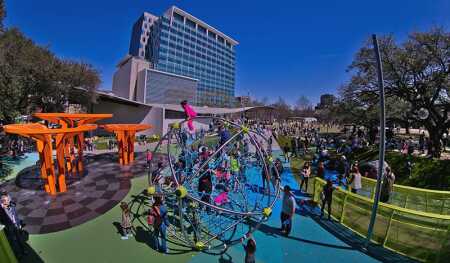The Case for Open Space, a new report from the ULI Center for Sustainability and Economic Performance, makes the business case for real estate investments in parks and open spaces. Developed through a collaboration between the ULI Sustainable Development Council and ULI’s Building Healthy Places Initiative, The Case for Open Space highlights the benefits for developers of incorporating parks and open spaces in their projects.
“Active open spaces are proven to deliver an excellent return on investment, often supplying far more in benefits than they cost to construct,” says Elizabeth Shreeve, chairman of the ULI Sustainable Development Council and a principal at the SWA Group. “These benefits accrue to private development while effectively strengthening communities and opening opportunities for all.”
The case studies highlighted in the report were drawn from 30 open-space projects across the United States supported by the private sector. Each demonstrates how mechanisms related to partnerships, funding, zoning, and local engagement have allowed developers to support project success while delivering significant community benefits. These benefits include increased buy-in from influential stakeholders such as public officials and investors; faster zoning approvals; the ability to capture strong market demand for parks and open space; and new sources of revenue.
The report examines five compelling projects that incorporate open space:
- Hunter’s Point South. Located in Queens, New York, Hunter’s Point South is a mixed-use affordable housing development that includes 925 permanently affordable housing units, 20,000 square feet (1,850 sq m) of new retail space, a new public school, a community facility, and an 11-acre (4.5 ha) waterfront park. When completed, the development is expected to spur over $2 billion in private investment and create about 4,600 jobs.
- Levy Park. A winner of the 2018 ULI Urban Open Space Award, Levy Park in Houston is a redeveloped, nearly six-acre (2.4 ha) neighborhood park where an innovative blend of public and private dollars helps cover park maintenance, operations, and programming expenses, enabling residents to take part in year-round park programming free of charge. After its redevelopment, Levy Park became the central component of an 11-acre (4.5 ha) urban activity center that now attracts about 10,000 visitors a week, up from only 75 visitors before redevelopment.
- Grand Park. A 12-acre (4.9 ha) public park is downtown Los Angeles, Grand Park has transformed a formerly underused public space into a vibrant gathering place that hosts cultural events, music performances, festivals, and fitness classes. In collaboration with Los Angeles County, a private developer invested $50 million to build the park in advance of plans to move forward with an associated mixed-use project nearby.
- Guthrie Green. Created in Tulsa, Guthrie Green involved transformation of a 2.6-acre former truck-loading facility into a highly programmed urban park. It has become the area’s leading destination since opening in 2012, drawing 3,000 people a week and sparking $150 million in public/private investment into a variety of commercial and residential projects in downtown Tulsa.
- Solaris Plaza. In Vail, Colorado, a developer repurposed a former parking lot and shopping center to create a mixed-use project with a central gathering place for residents and visitors. Solaris Plaza hosts year-round events such as a weekly farmers market and the GoPro Games. While Vail operates the space, the developer provided capital expenditures for the plaza and is responsible for its maintenance.
“This report aims to provide a range of ideas and inspirations for owners and real estate developers as they consider whether and how to invest in the public realm,” said Shreeve. “The study points to a winning formula: when undertaken thoughtfully, the creation of privately owned or operated, community-accessible open spaces can provide equitable access to resources, strengthen communities, reduce execution risk, and contribute to a solid bottom line for real estate investment.”
The Case for Open Space: Why the Real Estate Industry Should Invest in Parks and Open Spaces was produced with support from the Robert Wood Johnson Foundation.





